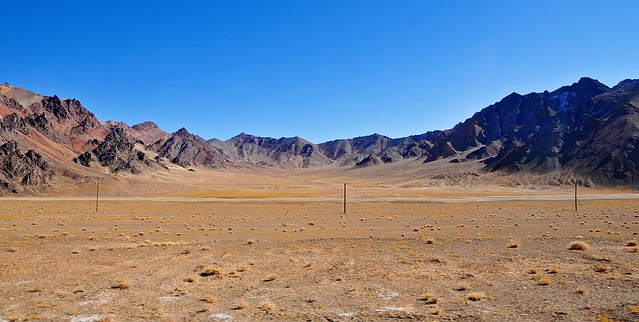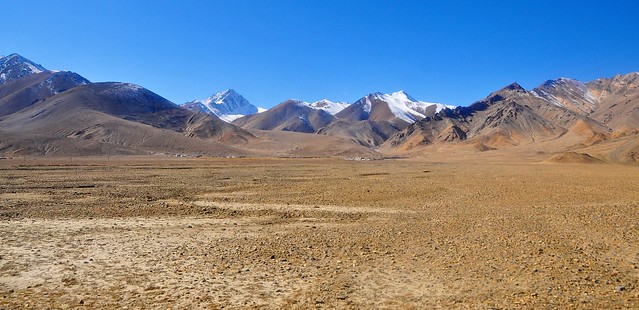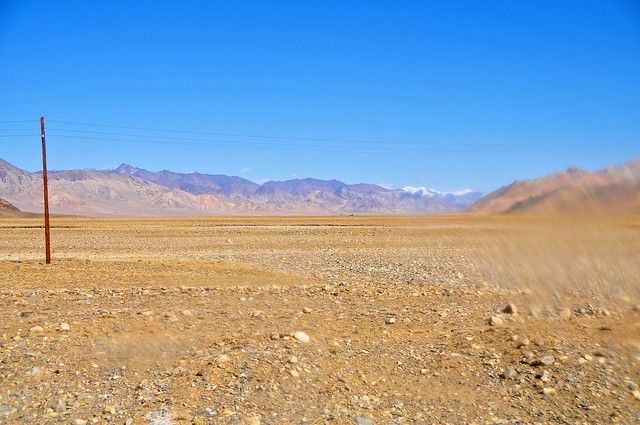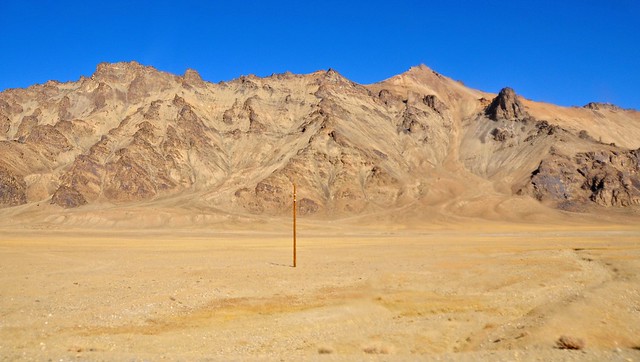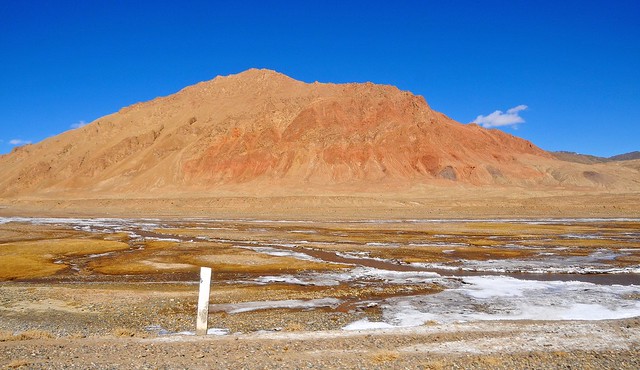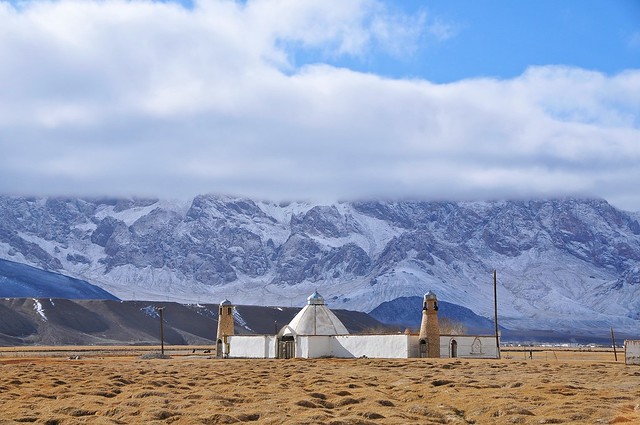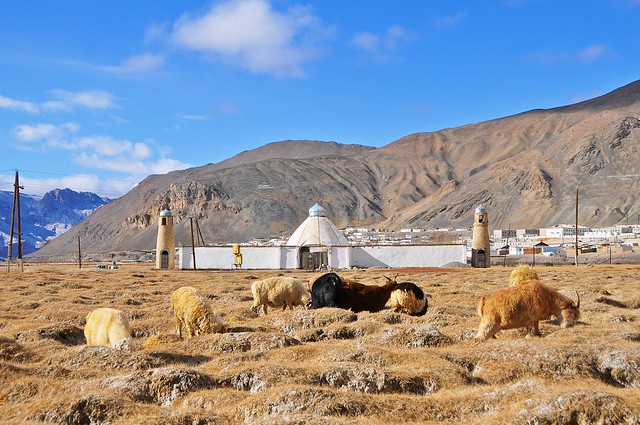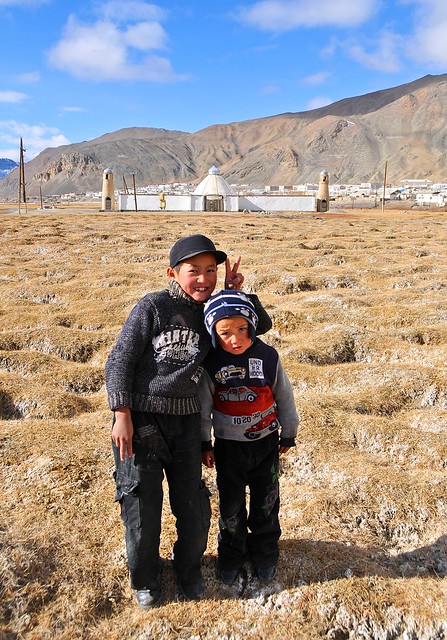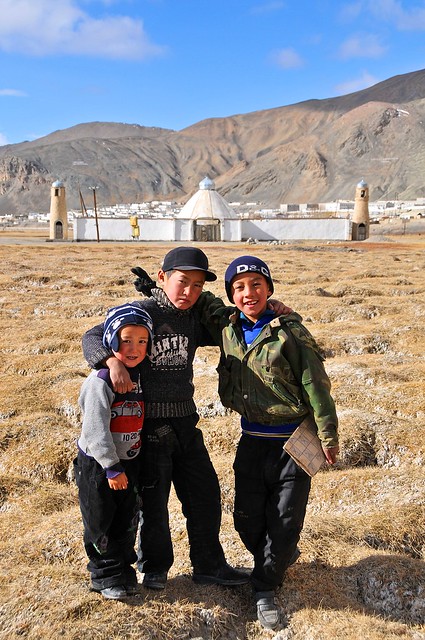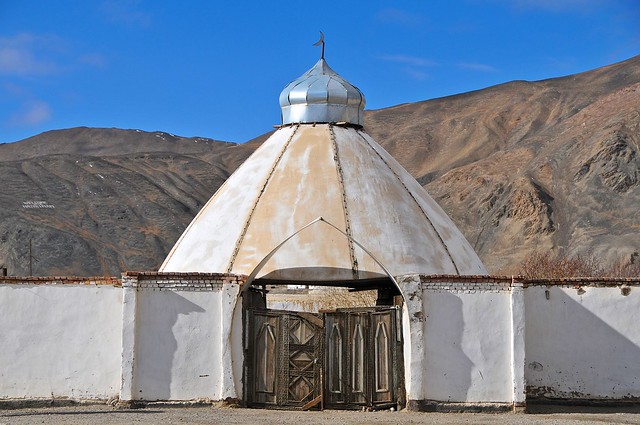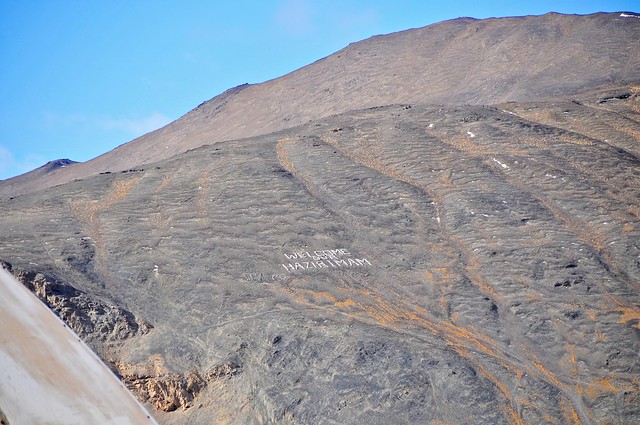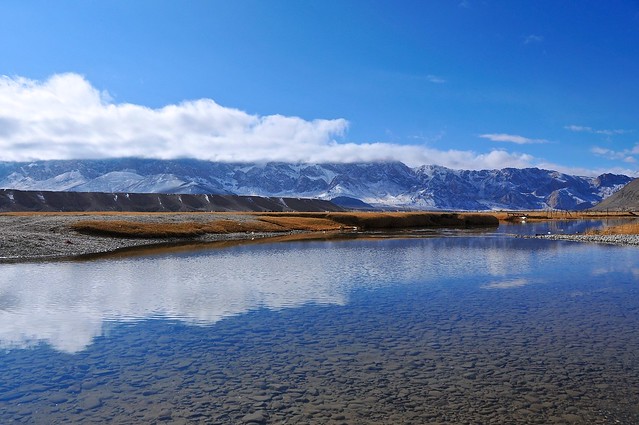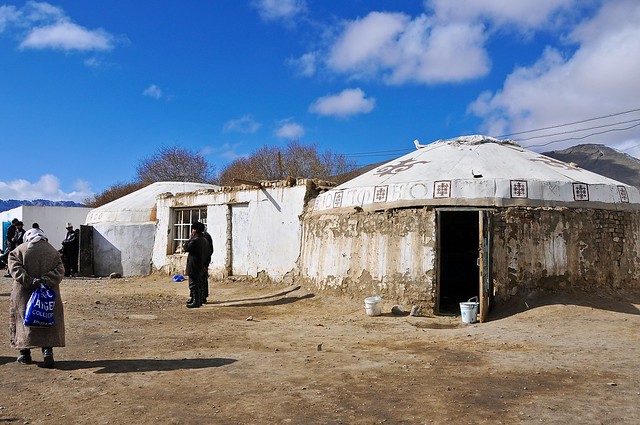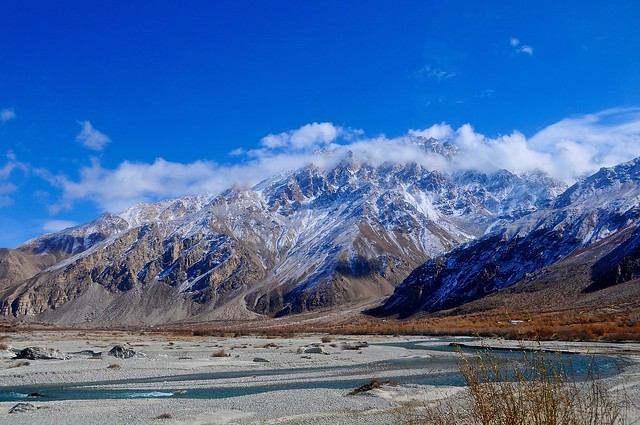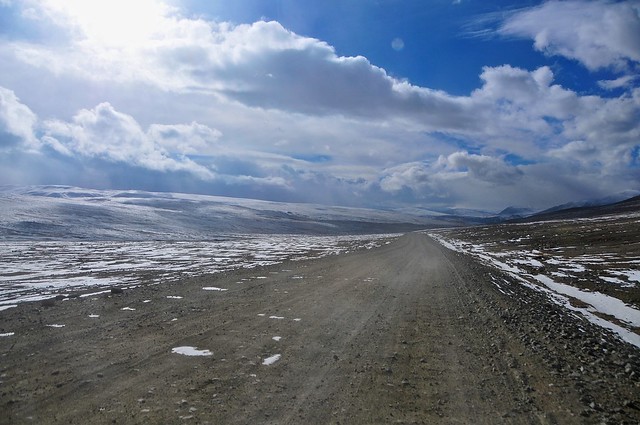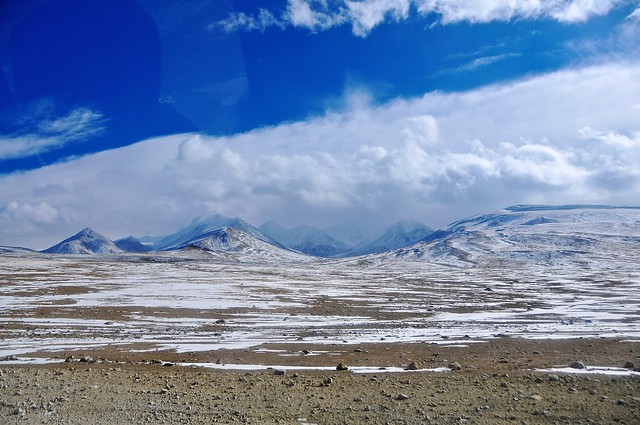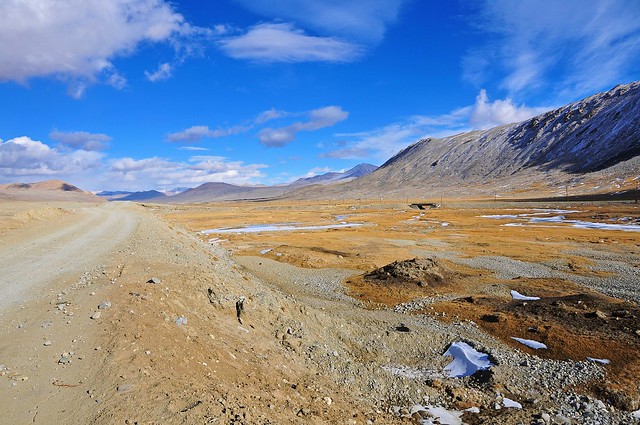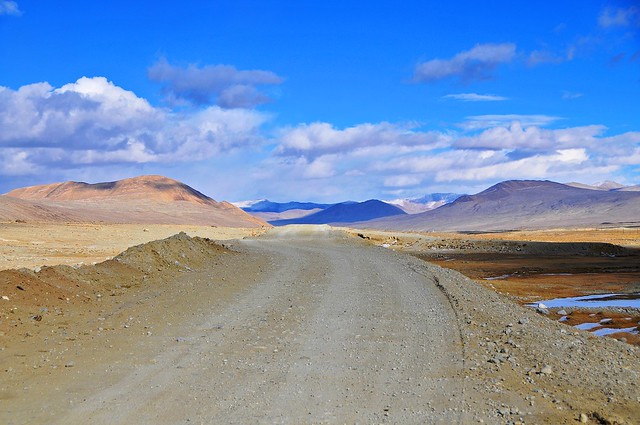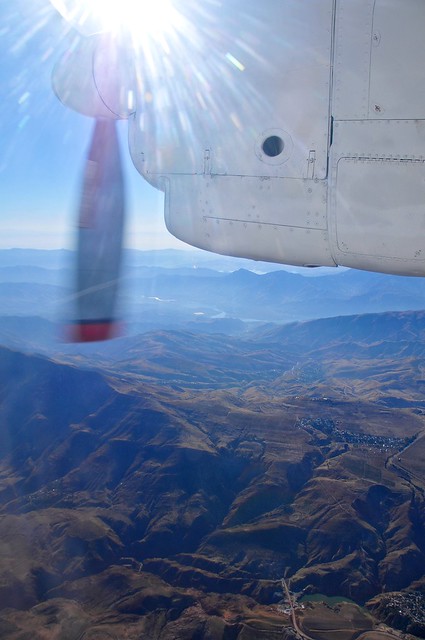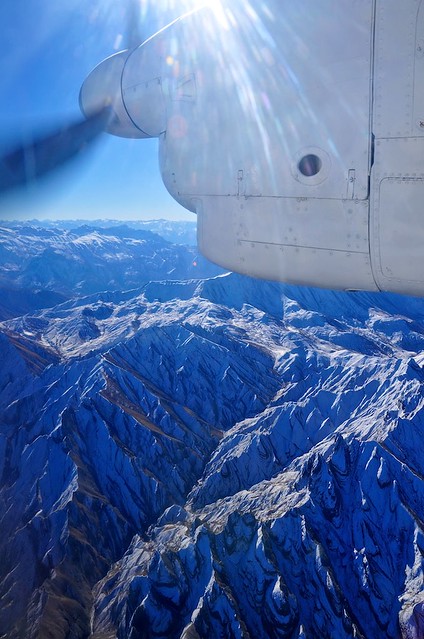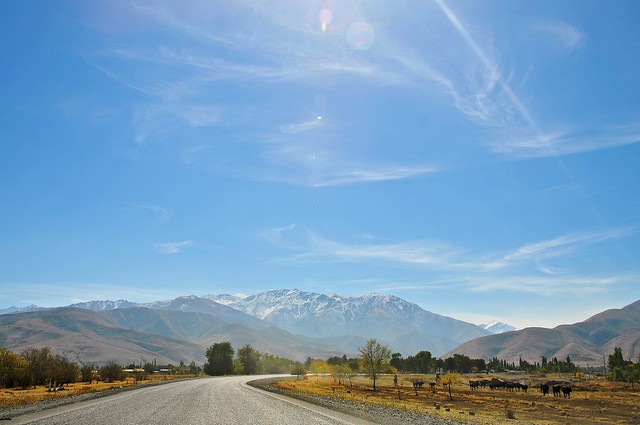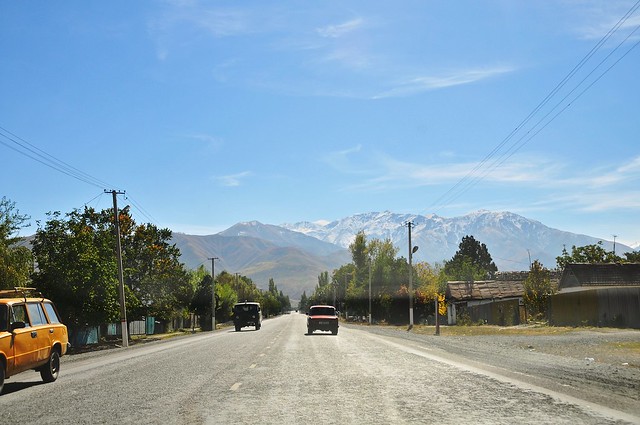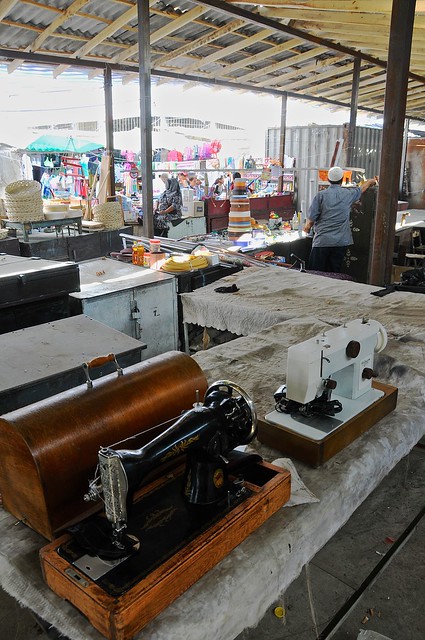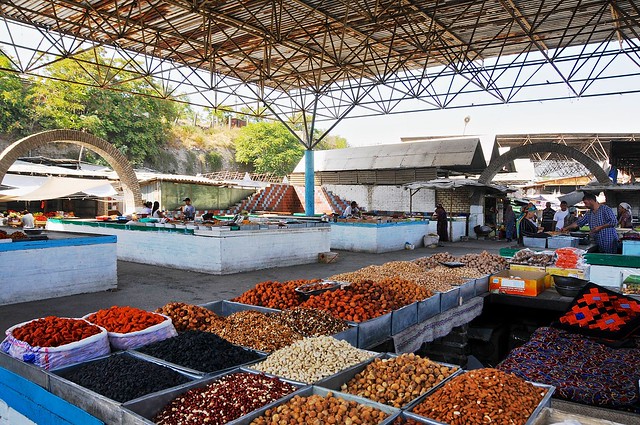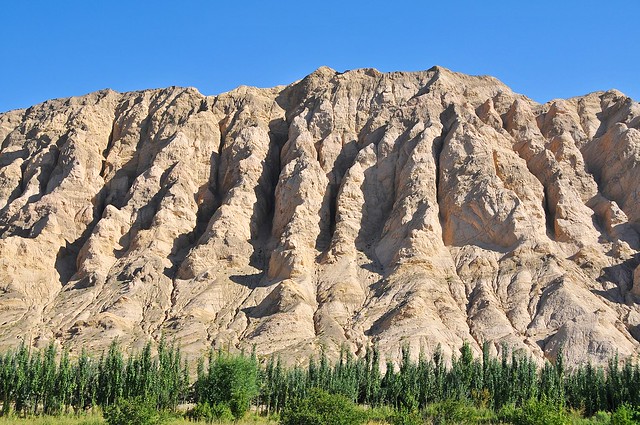After three nights in Arslanbob, I decided to head to Bishkek. The American tourist staying at my homestay was heading to Sary Chelek (which was highly recommended by a couple of Kyrgyz people I spoke with, but a bit off the beaten trail) and agreed to give me a ride down to Kochkor-Ata, from where I could catch a ride to Bishkek. I knew that the price of a ride from Osh to Bishkek was 1,000 som, so I figured that a ride from Kochkor-Ata—about two hours closer—should be cheaper. Despite that, I had been quoted the same 1,000 som price from both Arslanbob and Jalal-Abad, which didn't make much sense. When we arrived at Kochkor-Ata we parked a bit away from the taxi stand and the Kyrgyz driver went out and negotiated a price (the Russian guide couldn't go, since as a white guy he would likely get quoted a tourist price), and it turns out that the going price actually was 1,000 som, even though we were a lot closer.
After waiting an hour or so for the car to fill up (share taxis only leave when full, even if it means waiting for hours—or sometimes even days—and only cars and not minibuses do the run between Bishkek and Osh), we started on our way. I've heard that minibuses used to do this run, but I honestly can't (or don't want to) imagine them bombing down the twisty mountain roads. Kochkor-Ata is on the northern end of the Kyrgyzstan Ferghana valley, and about 65 km away in Tashkomur the road leaves the valley and starts cutting through mountain valleys to the north.
At first the road follows the Naryn river, and you soon reach a hydroelectric dam, behind which lays Toktogul reservoir. The road skirts the reservoir, and instead of following the Naryn river on the other end, it continues to circle around the north end of the reservoir and climbs another pass before emptying out into the wide, long Suusamyr valley. This valley, in its width and length, is very similar to the Alay valley at the southern end of the country, and through which I entered from China, with the important difference being that it is almost 1,000 meters lower, at about 2,200 meters, meaning it is greener and more hospitable for a longer time. Both valleys are gorgeous wide grasslands with mountains to the north and south, however, and had I been there in the height of summer it would have been nice to spend some time there.
Caravanistan has a nice feature giving you an idea of what you can see on this road (though some of the pictures are a bit out of sequence), as does
this cyclist's blog.
 |
| Looking north in the Suusamyr valley. |
 |
| View from a gas station along the M41 in the Suusamyr valley. |
About halfway through the Suusamyr valley, however, the road turns to the north and you make a long climb up relatively gentle slopes until you come to the upper reaches of the mountains, where you find a 2.5-kilometer-long tunnel through the top of the range at the Too Ashuu pass. Coming out of the tunnel, the northern side is nothing like the southern side, as it's all craggy mountains and steep slopes, and the road switchbacks down into the canyon-like valleys before emptying out into a fertile and heavily populated valley that runs to Bishkek. And although the road here is straight and flat, it's just about the slowest part of the trip since it's not a proper highway but a road through populated areas where it basically acts as main street for each of the respective towns and villages it crosses.
We arrived in Bishkek and were dropped off near the Osh bazaar in the western part of the city, and I hopped a bus and made my way to the Sakura Guesthouse, a very popular hostel owned by a Japanese man but run by his Kyrgyz wife. I think all the guy did was drink beer with his friends at night, and make noise well after quiet hours started, but I suspect the concept and standards behind the hostel were his. What do I mean by this? Well, it had spotless toilets and showers with good water pressure and lots of hot water, extremely clean rooms, and free wi-fi. Although it is hard to find, has a tiny kitchen, and a cramped outdoor common area, it seems to be the place where everyone in Bishkek goes (especially cyclists and those who are driving their own cars or motorbikes). Because it's popular and because people tend to stay in Bishkek for a while to collect visas and catch up on civilization, it's extremely busy and you often have people sleeping in the hallways or on the roof in the multi-story main building (which is quieter than the dorm room near the entrance and kitchen).
In doing some research while writing this entry, it appears that the owner has been involved in
a highly questionable incident with a young, black-out drunk Japanese tourist, and I can't say that this seems highly out of character for him. If you are a female tourist, be careful around him and definitely do not drink with him.
Like so many others in Bishkek, I also needed to get some visas sorted out. The key ones were the Tajik and Iranian ones. Tajik visas are relatively straightforward to get, and Bishkek is a good place to get them. They can grant single-entry visas on the spot for $75, or in a week for $55, with a double-entry costing $10 more. You just need to visit their embassy and fill out a form. If you want it on the spot, they process it immediately. If you're willing to wait, they just put your application on a pile and retrieve it when you come back: there's no need to pay in advance or leave your passport. I took the one-week service, since I knew I would need to come back to Bishkek later, and double-entry, since I knew I might want to visit the Afghan Wakhan.
The Iranian visa is probably the most difficult visa of all the ones I needed—and this was before citizens of all English-speaking countries needed a tour guide to get a visa. The main stumbling block is that you need an invitation from a tourist agency in order to get a visa. In theory, you provide an itinerary to the tourist agency, they apply to the government, and the government either approves you or rejects you, and then the agency sends you a confirmation number that you present to an embassy to which the tour agency has said you'll apply for your visa. The problem is that there are a mall number of people are randomly rejected, and that a number of agencies have a reputation for giving rejected applicants false confirmation numbers, so it's important to select a decent agency. The second problem is that North American banking regulations are quite strict, and it is very difficult to actually pay for these visa invites, as most payments to anyone even remotely associated with Iran will be blocked. I had payments to multiple UK bank accounts blocked, and was only able to successfully make a payment by giving a Dutch traveler some cash and asking him to make the bank transfer for me from his bank. I went to the Iranian embassy in Bishkek, but they said they couldn't find my confirmation number, and suggested I come back later. Uh oh. I confirmed with my agency that they had sent my confirmation number to the Bishkek embassy, and then hoped it would be there when I came back to Bishkek.
Aside from going to embassies, I walked around Bishkek and took in the city. Bishkek used to be known as Pishpek, which is the name for the churn
used to make kumys, which seems about as apt a name as any for a
settlement in this dairy-mad, kumys-guzzling country.
Today, the city is a fairly nice, relaxed place. And while Osh is the second-biggest city in the country, it pales in comparison to Bishkek, which seems like a city in ways that Osh simply doesn't. A little shabby, and not well integrated into the global marketplace (meaning that Western brands are unavailable or expensive), but nevertheless much more cosmopolitan and glamorous in a decayed Soviet kind of way.
One thing you may notice is a gender imbalance. You see a lot more women in the streets than you do in Osh, and while this might make some sense given how conservative Uzbek society is and how modern Bishkek is, the reality is that Bishkek is a city dominated by women. Indeed, much of Kyrgyzstan is, and
Tajikistan is even worse. I later spoke to a couple of French journalists helping establish a French-language newspaper in Bishkek who said that over 60% of the working-age population in Bishkek was female, since so many men go to work in Russia. When you go into poorer villages and talk to people, you see old men, children, and women. Talk to them (family is usually the second or third question that arises, after where you're from and how old you are) and they'll tell you about their son, brother, or husband who is in Russia, working hard to send money home. If they're lucky, they've seen him in the past year. In central Bishkek banks are most noticeable by their signs advertising remittance services. It's even worse than the Philippines (another country highly dependent on foreign remittances from overseas workers), and kind of like the reverse of the cluster of towers in Hong Kong that cater to Filipina domestic workers wanting to send money home.
 |
| Your bar has a dress code? Well, all the classy bars in Bishkek have face control, too. |
 |
| Soviet-style monumental architecture is often kind of interesting. This building was being turned into a casino. |
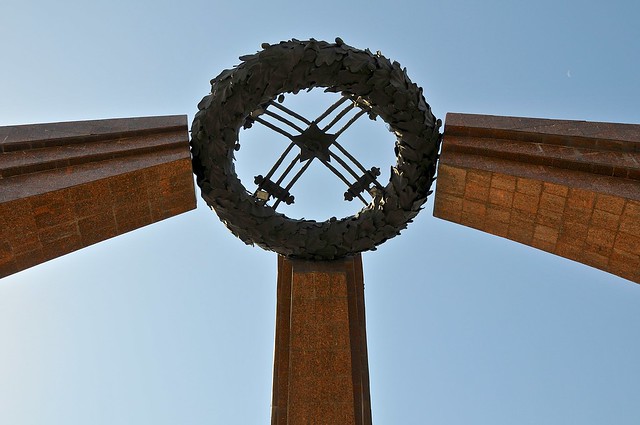 |
| This circle with crossed strakes is what the central aperture, or tunduk, of a Kyrgyz yurt looks like, and is the motif on the Kyrgyzstan flag. Here it appears on the Monument of Victory. |
 |
| Typical Soviet statuary, this one to general Panfilov. |
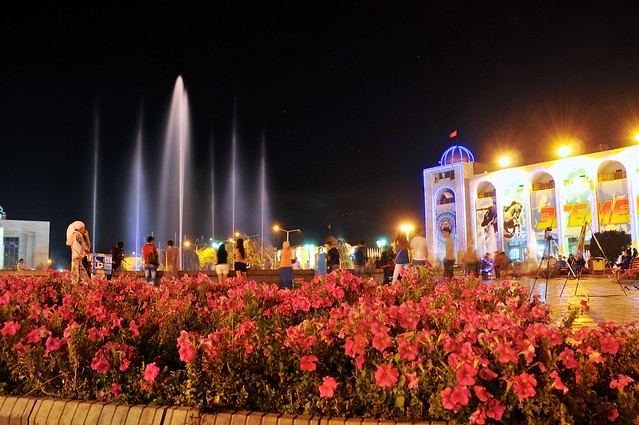 |
| There is a light show by the fountains in downtown Bishkek. Here they have the souvenir photographers with digital cameras and printers you often see in low-income countries, as well as people selling cheap Chinese toys. One of the popular attractions for young males was a test of strength involving a thick pull-up bar that could freely-rotate. The object was to do a pull up and keep your position as long as possible—but since the bar could rotate, you couldn't use a natural pull-up grip. |
When I had originally applied for my Kazakh visa, in Mongolia, I had originally thought that I would be entering Kazakhstan from China. Instead, I had come up through Kygyzstan. This was a bit of a problem because my visa was only good from August 22 to September 21, which meant I had been under some time pressure to make it to Kazakhstan before my visa ran out. I thus only spent one full day in Bishkek before going to Kazakhstan—this was probably a good idea given that visas mean one has to spend more time in Bishkek than one might otherwise like. (At least it's a better place to spin your wheels than Ulaanbaatar.)
Because the Sakura is such a popular place, I was able to hear about a new guesthouse that had just opened in Almaty—a godsend since the city is expensive and there aren't any other hostels there. I heard about it from this Indian-American guy who has been traveling continuously for years, making money by programming on projects that require no face time. He had been to something like 130 countries, and his goal was to visit more countries than Hillary Clinton's 180-something countries, if not to visit every UN-recognized country in the world. This seemed like a bit of a strange goal for me, especially since he was only spending 3 days in Kyrgyzstan before crossing it off and moving on to the next country. His advice on the new Apple Hostel in Almaty was very solid, however.
Budget
September 10, 2012, from Arslanbob to Bishkek: 1765 som
- Share taxi to Bishkek: 1,000 som
- Dorm at Sakura: 350 som
- Snacks and drinks: 210 som
- Dinner: 205 som
September 11, Bishkek: 1051 som
- Dorm at Sakura: 350 som
- Samsa and dumplings: 60
- Drinks, fruit chocolate, toothbrush, vegetable peeler: 180
- Fruit and snaks: 90 som
- City bus: 16 som
- Passport photo: 100 som
- Sandwich and iced tea: 40 som
- Dinner: 215 som
